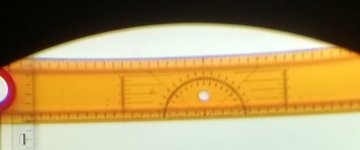Henry,
After an abortive attempt to use a decent camera I had to resort to using a hand held phone at an angle so apologies for poor alignment and focus. It was all a bit rough and ready. The circles were close to 70mm at about 10m. The first is the Vanguard Endeavour EDII 8x42 which appears to my eyes to have have the merest trace of pincushion, field curvature and edge softening, but as binoculars go, very flat. The circles appear to have retained their symmetry I'd say. The second is the ZenRay Prime 10x42. This has more pincushion and field curvature than the Vanguard but still a lot less than my other binoculars. I'd still categorise this as a flat view, but not a flat as the Vanguard. I think the camera must have been tilted slightly as even the left circle has a little vertical compression but the right circle has obvious horizontal elongation.
David
After an abortive attempt to use a decent camera I had to resort to using a hand held phone at an angle so apologies for poor alignment and focus. It was all a bit rough and ready. The circles were close to 70mm at about 10m. The first is the Vanguard Endeavour EDII 8x42 which appears to my eyes to have have the merest trace of pincushion, field curvature and edge softening, but as binoculars go, very flat. The circles appear to have retained their symmetry I'd say. The second is the ZenRay Prime 10x42. This has more pincushion and field curvature than the Vanguard but still a lot less than my other binoculars. I'd still categorise this as a flat view, but not a flat as the Vanguard. I think the camera must have been tilted slightly as even the left circle has a little vertical compression but the right circle has obvious horizontal elongation.
David









